The REAL Takeaway From The CDC Study On HIV/AIDS In Transwomen
The CDC is clueless.
Seriously, they are. They conducted a study in seven urban areas of Male-To-Female transsexuals, regardless of surgical status, asking about HIV status along with a number of other questions, but like so many who have no clue as to the Two Type Taxonomy, simply assumed that everyone who is “trans” is in the same etiological taxon, with similar behaviors. Clueless.
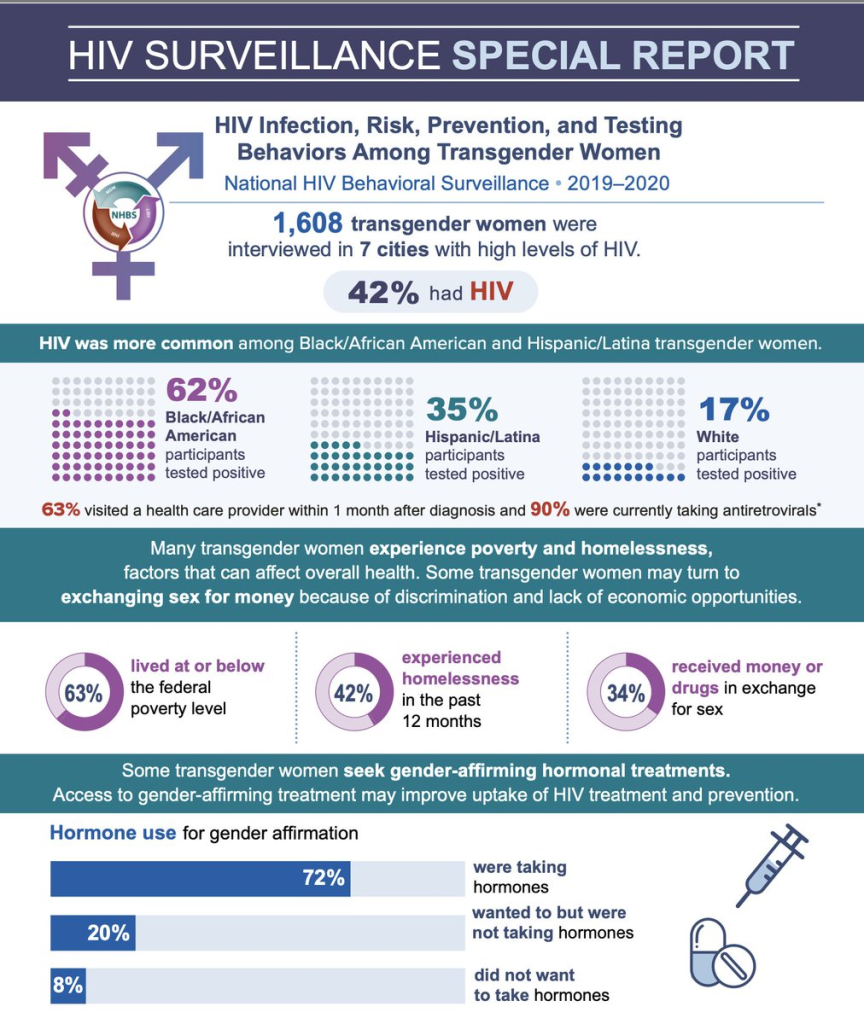
Because of this, they seem surprised that unlike in the gay and bisexual male population, black and latina transwomen were more likely to use PrEP medications (anti-viral drugs that protect one from HIV) than white. Of course they are! As was documented by Nuttbrock, most white transwomen are heterosexual autogynephilic (AGP) while most black and latina transwomen are Homosexual Transsexuals (HSTS). White AGP transwomen are simply NOT at the same high risk of getting HIV as HSTS of any race and they know it, thus are less likely to use PrEP.
Only 11% of the CDC’s study respondents were white, which is dramatically lower than the percentage at the national level. This indicates that the study, given its urban catchment and the networking effect of how the subjects were recruited from other subjects, this study was very likely mostly of HSTS transsexuals. This is born out by the fact that 77% reported receptive anal sex during the past year — and 55% reported condomless anal sex — but only 14% reported vaginal sex with women.
So, why did the CDC researchers ignore the two type taxonomy and fail to report that the single highest risk factor for HIV infection in the United States among transwomen is being an HSTS and that AGP transsexuals are at much lower risk? Healthcare workers need to know this differential risk factor.
The write-up did acknowledge that the study was limited by the fact that they had not captured those that would likely be at lower risk… but failed to note that that difference came from the disparities experienced between AGP and HSTS transsexuals.
Further Reading:
Nuttbrock data on HSTS/AGP ratios by race
Further External Reading:
Reference:
Autogynephiles Are More Likely To Be Left Handed Than Homosexual Transsexuals
Most people are naturally right handed. The number of left handed people has been studied and shown to be a little more than 10% of the population. Interestingly men are more likely to be left handed than women by several percent.
It has been reported in the science literature for several decades that transsexuals, both FTM and MTF are more likely to be left handed than than the general population, not just more “non-right-handed” (meaning ambidextrous to some degree).
In the Orlebeke (1992) paper 19% of both MTF and FTM transsexuals were left handed compared to 11.2% of the general population of the Netherlands. Sadly, they did not report data on homosexual vs. non-homosexual. However, several other studies did.
Slabbekoorn et al. (2000) included only homosexual MTF transsexuals (HSTS) showing only 10.4% were left handed compared to 10.6% of the controls. Another study by Richard Green showed that only 10.8% of HSTS were left handed. Both studies show that HSTS have the same incidence of left handedness as the general population.
One of the reasons that HSTS do not show elevated left handedness is that only right handed people exhibit the Fraternal Birth Order Effect (FBOE) which many HSTS do.
I was intrigued so I conducted a poll on Twitter from 9/4/2023 until today, 9/6/23 asking “AGP” and “HSTS” self-identified MTF transsexuals to report their handedness, right, left, both. I hypothesized that I would see the same or similar numbers as the earlier studies for AGPs. I also predicted that some non-HSTS would misrepresent their sexuality, as is well known to happen and that the numbers for the HSTS group would be slightly higher than those reported by Slabbekoorn and Green.
Both AGPs and HSTSs reported similar numbers of “both” handedness, being less than 100% right handed, but very different amounts left handedness in agreement with the above studies and my hypothesis that a number of AGPs are misrepresenting their sexuality on Twitter. AGPs have higher incidence of left handedness than the general population, while HSTS do not.
Here is the poll result for the AGPs N=110:
- Right 62.7%
- Left 18.2%
- Both 19.1%
Here is the poll results for the “HSTS” (likely mixed with some AGPs) N=60:
- Right 68.3%
- Left 13.3%
- Both 18.3%
Thus, this is yet another bio-statistical difference between AGPs and HSTSs supporting the Two Type Taxonomy.
Further Reading:
Transsexuals misrepresenting their sexuality
Consilience of Evidence supporting the Two Type Taxonomy
References:
Orlebeke, J. F., Boomsma, D. I., Gooren, L. J. G., Verschoor, A. M., & Van Den Bree, M. J. M. (1992). Elevated sinistrality in transsexuals. Neuropsychology, 6(4), 351–355. https://doi.org/10.1037/0894-4105.6.4.351
Slabbekoorn D, van Goozen SH, Sanders G, Gooren LJ, Cohen-Kettenis PT. The dermatoglyphic characteristics of transsexuals: is there evidence for an organizing effect of sex hormones. Psychoneuroendocrinology. 2000 May;25(4):365-75. doi: 10.1016/s0306-4530(99)00063-3.
Ray Blanchard PhD (2008) Review and theory of handedness, birth order, and homosexuality in men, Laterality, 13:1, 51-70, DOI: 10.1080/13576500701710432
Comments Off on Autogynephiles Are More Likely To Be Left Handed Than Homosexual Transsexuals
Consilience: The Many Independent Lines of Evidence for the Two Type Taxonomy of MTF Transsexuality
Science depends upon multiple lines of reproducible evidence coming together to support a theory, a property called consilience. In this case, we have that in abundance. In fact, I count nineteen independent lines of evidence that support not only that there are two types of MTF transsexual, but that the difference is taxonic, not merely dimensional.
Studies, going back to the 1970’s, looking at the correlation between sexual orientation, age of transition, childhood gender atypicality, appearance, biodemographics, cross-cultural correlations, neuroanatomy, and autogynephilia consistently find two statistically significant groupings with very large effect sizes. Most importantly, evidence, based on predictions regarding the taxonomy, continue to support the two type taxonomy.

One group is primarily attracted to men, transitions quite young, passed as girls/women with relative ease, were noted to be feminine (sissy boys) by parents and teachers as children, preferred female playmates, avoided rough’n’tumble play, and were unlikely to report finding wearing women’s clothing to be sexually arousing (less than 15% of self identified androphilic MTF report erotic arousal to cross-dressing).
The other grouping was sexually attracted to women (as evidenced by extensive sexual experience with women, marriage, and siring children) but may identify as bisexual or asexual, transitioned later in life, rarely passed successfully as women, were considered to have been typical boys (“boyish”) by their parents and teachers, and were very likely to report finding wearing women’s clothes to be, or once had been, sexually arousing (85% of self identified gynephilic MTF report erotic arousal to cross-dressing).
No other groupings had such strong statistical signals.
Attempts to find a third group fail, as every possible third group, based on MTF transsexual narratives, claims that they represent such a third group, show that they are in fact simply a subgroup of the second group, with nearly the same level of autogynephilia, the same age of transition, the same level (lack) of gender atypicality in childhood, etc.
When using statistics with people, one always expects “noise”: false positives and false negatives: People misunderstand the questions, misinterpret their own feelings and behavior, prefer not to provide definite answers, wish to appear to better advantage, or simply like to introduce bogus answers to cause mischief… so the statistics can never be 0% vs. 100% in any study; but 15% vs. 85% is a very, very strong statistical signal and large effect size in psychology studies. In fact, this statistic says that even with the false response rate, “late transitioning” transwomen are over 650%, five and a half times (5.5X), more likely to report being sexually aroused by cross-dressing as those “early transitioners” who transition in their teens. Indeed, had these numbers been any closer to 0% vs. 100%, knowledgeable scientists / psychometricians / statisticians would have flagged the data in peer review of these papers as being “too good to be true”, given well known real world difficulties in psychology research.
#1
Associations between autogynephilia and sexual orientation
in MtF transsexuals and transgender persons
| Study | Nonandrophilic/ Autogynephilic | Nonandrophilic/ Nonautogynephilic | Androphilic/ Autogynephilic | Androphilic/ Nonautogynephilic | Cohen’s ω | |||||
| Blanchard (1985) | 46 | 17 | 15 | 85 | .58 | |||||
| Blanchard et al. (1987) | 60 | 13 | 5 | 47 | .72 | |||||
| Lawrence (2005) | 178 | 21 | 6 | 9 | .36 | |||||
| Smith et al. (2005) | 28 | 16 | 18 | 40 | .32 | |||||
| Nuttbrock et al. (2011) | 131 | 48 | 90 | 301 | .48 | |||||
| TOTALS (N=1174) | 443 | 115 | 134 | 482 | .58 |
Note: The four center columns display numbers of participants.
Science depends upon repeatability, and these results regarding sexual orientation and autogynephilia have been replicated by Buhrich (1977), Freund (1982), Blanchard (1985, 1987), Doorn (1994), Smith (2005), Lawrence (2005), and Nuttbrock (2011), Laube (2020), in separate studies spanning five decades, collectively involving over a thousand transwomen to date. In fact, this is one of the most repeated and reconfirmed scientific finding regarding transsexuality. While Blanchard coined the term “autogynephilia” in the late ’80s, the phenomena had been noted and studied before using various synonymous terms such as “fetishistic transvestism” and “fetishistic femmiphilia”. This is not the only statistic that shows that there are two and only two types.
#2
The second most important statistical evidence is biodemographics. One of these is that transgender leanings tend to run in families, but not the same families. That is to say, that the two types are almost never found in the same family, but it is common for several HSTS siblings to transition together, while it is common to find two autogynephilic males in the same family. Click Here to Learn More
#3
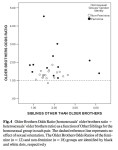
Another biodemographic is that HSTS, as a group, have more older brothers, and more brothers than sisters, than the general population and gay men, while AGP TS have the same as the general population. This means that for both types, the condition has in-born factors, but not the same factors. There is no overlap between the two. This alone is powerful, and likely conclusive, evidence that the two taxons have differing etiologies. Click Here, Here,
#4
The next statistical finding is that HSTS are extremely unlikely to have paraphilic sexual interests, similar to non-transwomen, while non-homosexual transsexuals are very likely to have such paraphilic sexual interests such as Bondage&Discipline, ‘forced feminization’, latex clothing, auto-erotic asphyxiation, etc., at rates that exceed the base rate for non-transgendered men, and far exceed the base rate for women. Since paraphilias tend to cluster, that is, that if an individual has one paraphilia, they are more likely to have another, it suggests that autogynephilia may itself be a paraphilia. Click to Learn More
#5
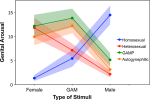
Analogously, AGP TS, non-homosexual transsexuals and cross-dressers are very likely to also be gynandromorphophilic (preferentially or at least equally attracted to other transwomen as to women) while HSTS are not. Click to Learn More
#6
An additional statistical finding is that the percentage of non-homosexual transsexuals in a country highly correlates with that country’s Hofstede Index for Individualism vs. Collectivism. That is to say, that non-homosexual transsexuals are far less likely to transition in countries that place higher value on collective family responsibility, while transkids are still likely to transition. Click to Learn More
#7
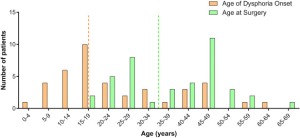
There is a distinct bimodal distribution in the age of severe gender dysphoria onset into early and late and of age of obtaining surgery that correlates and demonstrates the separate life arcs of the two types. Click to Learn More
#8
Although not often discussed, there is data showing that homosexual transsexuals are genitally “avoidant”, that is to say, that though they will joyfully have sexual relations with their boyfriends, as “bottoms”, they assiduously avoid use, contact, and often even visual exposure, of their own pre-op genitalia. Non-homosexual transsexuals however usually have no such reservations, including active participation in penetrative vaginal and oral sex, often siring children, with their wives / girlfriends. Click to Learn More
#9
The type of genital surgery that transwomen elect to have is different depending upon sexual orientation and age with older and non-androphilic transwoman are several fold more likely to elect surgeries that do NOT provide a neo-vagina. Click to Learn More
#10
Just as men are taller than women, on average, there has long been anecdotal and some clinical data that show that non-androphilic transwomen are taller than androphilic. Click to Learn More
#11
It may seem obvious, but women are more “feminine” than men when they were children, as noted by family and teachers. Androphilic transwomen are notably more feminine than non-transsexuals while non-androphilic MTF transsexuals are not. Click to Learn More
#12
Men are far more likely to be autistic than women. On an autism scale, men score higher than women. The exact same scores are found for non-androphilic vs. androphilic MTF transwomen Click to Learn More:
Group: Men Women Non-Androphilic Androphilic
. MTF N=129 MTF N=69
Score (SD): 17.8 (6.8) 15.4 (5.7) 17.4 (7.4) 15.0 (5.6)
#13
Further, there is the curious statistic that while HSTS have as a group, average IQ=100, non-homosexual transsexuals exhibit, as a group, significantly higher IQ (121.7 in one clinical study), very unlikely to have happened by chance. Click to Learn More
#14
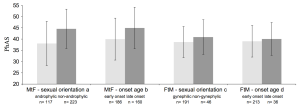
Clinical comparisons support the oft noted observation that exclusively androphilic transwomen (HSTS) ‘pass’ better than non-homosexual transsexuals, that they are physically more feminine than non-homosexual transsexuals and transgendered MTF people. Click to Learn More
#15
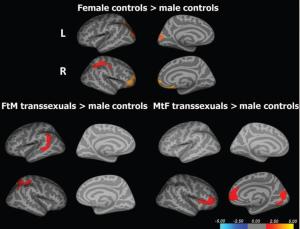
There is growing evidence that exclusively “homosexual”, both MTF and FtM, transsexuals have cross-sex brain features that can be measured using modern MRI scans while non-homosexual transsexuals do not, but may have other features, not found in controls, that are not sexually dimorphic. This result, first obtained in 2011, confirmed predictions made by Blanchard in 2008. Click to Learn More
#16
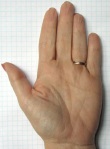
Although very tentative, there is 2D:4D measurement evidence that HSTS MTF have feminized hands indicating that they had lower testosterone exposure in utero than control men while late onset MTF transsexuals do not. Even more intriguing is the data that suggests that late onset FtM are not only very different than early onset, but are actually MORE feminine than control women. Click to Learn More
#17
Exclusively feminine androphilic (HSTS) MTF transwomen, have a distinctive hormonal (Lutinizing Hormone) response to acute introduction and withdrawal of estrogen which is similar to natal females, while non-exclusively androphilic MTF transwomen respond the same as heterosexual non-transgendered men. This is laboratory diagnostic “proof” of the two type taxonomy. Click to Learn More
#18
There are clinical observations that AGP transsexuals have far more emotional distress and rates of mental illness than HSTS. Click to Learn More and Here
#19
Autogynephilic transsexuals have higher prevelence of left handedness at ~19% than both the general public and HSTS at ~10.5% Click to Learn More
For more information click on the category Confirming Two Type Taxonomy.
Comments Off on Consilience: The Many Independent Lines of Evidence for the Two Type Taxonomy of MTF Transsexuality
Sex Reassignment Surgery Demographics in the Netherlands
Our favorite folks in Amsterdam have provided data set on MTF transsexuals receiving SRS in their clinic covering 40 years. The paper is openly available online, not behind a paywall, so you may read it for yourself. But I have a few observations and comments regarding the data and the authors’ comments.
First, let’s look at the data, reorganized into putatively HSTS vs. AGP. (Yes, given all we know about MTF transwomen, I will assume that all non-exclusively androphilic transwomen are AGP.)
Table 1
Demographics of transgender women undergoing primary genital gender-affirming surgery at the authors’ institution between January 1980 and January 2020
| Demographics | Total | Vaginoplasty | Orchiectomy | GCV |
|---|---|---|---|---|
| Number | n=1531 | n=1468 | n=44 | n=19 |
| Age at surgery (SD=1) | 33 (25–44) | 33 (24–44) | 32 (26–45) | 54 (45–60) |
| Sexual orientation (self report) n= | 699 | 645 | 42 | 12 |
| HSTS n= (%) | 372 (53) | 357 (55) | 13 (31) | 2 (17) |
As the authors noted, “Individuals who opted for GCV (vulvaplasty only, no vaginoplasty) were generally older, had no history of puberty suppression, and were more frequently sexually oriented towards women.” The same could be said for orchiectomy as well. HSTS are much more likely to want/need vaginoplasty over other possible choices as one would expect, so as to be able to have vaginal intercourse with men.
The authors made a comment that I found ahistorical. They believe that GCV is a relatively new procedure. It is not. In fact, Christine Jorgensen had GCV only in 1952, as reported by her surgeon, Dr. Christian Hamburger, as neither of them desired to facilitate sex with men. Similarly, “orchies”, as we called them back in the 1970s, was common for both HSTS and AGP in the early 20th through the mid- to late-20th Century due to greater ease of obtaining them. (Some of this was due to the Eugenics Movement, which was only too happy to sterilize “perverts”.)
Finally, the authors wrote about encouraging “fertility preservation” but seem to lament that it isn’t possible for those who begin puberty blockers early, “The increase in individuals starting puberty suppression at early pubertal stages, when serum testosterone concentrations are insufficient for spermatogenesis, may lead to an increase in individuals without options for preservation of fertility.” This strikes me as “unclear on the the concept” as why would such MTF early transitioners, who are all HSTS (as even this clinic’s own data attests), want or need to cryostore sperm. Just who will they impregnate, their future husbands?
Reference:
Van der Sluis, et al., “Surgical and demographic trends in genital gender-affirming surgery in transgender women: 40 years of experience in Amsterdam”, British Journal of Surgery, Volume 109, Issue 1, January 2022, Pages 8–11, https://doi.org/10.1093/bjs/znab213
Comments Off on Sex Reassignment Surgery Demographics in the Netherlands
American Psychiatric Association Supports The Two Type Transsexual Taxonomy
Very frequently, I and others are challenged with claims that the two type taxonomy of transsexuality had been “debunked”. When I show that that isn’t true, my interlocutors said something to the effect that, “Well, I’ll go with the American Psychiatric Association (APA) over your fringe science.” They were assuming that the APA had “debunked”, or otherwise disavowed, the taxonomy. Nothing could be further from the truth as we explore what APA documents show; most critically, how the Diagnostic & Statistical Manual of Mental Disorders, Revision Five (DSM-5) explains and supports the taxonomy and describes the two types.
But first, we need to explore a bit of nomenclature and its history. Over the decades, the two types have been given different labels:
Homosexual Non-Homosexual / Autogynephilic or Autoandrophilic
nuclear non-nuclear / marginal
core non-core / marginal
Ego-syntonic Ego-dystonic
Androphilic Gynephilic (for MTF only, the reverse is used for FtM)
True- Pseudo-
Primary Secondary
Group One Group Three (Anne Vitale 2001) (For MTF only, “Group Two” for FtM)
Early Onset Late Onset
Young Older Transitioner
Early Late Transitioner
Transkid Adult
Most people who have recently learned of the taxonomy ascribe it to just one researcher, Dr. Ray Blanchard. While he was a prolific publisher of studies of the taxonomy, he did NOT discover or create it. He did, however, coin one of the terms used to describe one of the types, “autogynephilic” (AGP) to fully and correctly articulate their nature and the role of autogynephilia in the etiology of their gender dysphoria. He contrasted this type with the description of the sexuality of the other type, using the then common convention of describing transsexuals’ sexual orientation based on their natal (biological / “assigned at birth”) sex, as “homosexual transsexual” (HSTS).
So, when exploring APA documents, we need to keep in mind that for MTF transsexuals, “homosexual” = “early onset” and “autogynephilic” = “late onset”.
Thus HSTS/AGP = early onset / late onset taxonomy.
I know that some will object and falsely claim that this is not the equivalent taxonomy or theory. But we have examples of scientific papers where they are used interchangeably. And more importantly, in the DSM-5 itself, the description and explication of the two types make it very clear that they are the same taxons and theory. There can be no honest quibbles. The DSM-5 fully documents, describes, and supports as our best current scientific understanding, the two type taxonomy and theory.
First, the DSM-5 defines (and thus acknowledges the existence of) autogynephilia in its glossary of technical terms on page 818,
“autogynephilia Sexual arousal of a natal male associated with the idea or image of being a woman.”
This definition is literally the same as Blanchard articulated. One cannot say the APA has “debunked” the existence of autogynephilia when they helpfully define it for use by their members and the public.
But let us continue. One of the key points of the two type taxonomy is that autogynephilia is often expressed as sexual arousal to cross-dressing, and though not always, it can be progressive and lead to gender dysphoria. The DSM-5 describes this very phenomena in its description of ‘transvestic disorder’ on pages 703-4,
“Transvestic disorder in men is often accompanied by autogynephilia (i.e., a male’s paraphilic tendency to be sexually aroused by the thought or image of himself as a woman). Autogynephilic fantasies and behaviors may focus on the idea of exhibiting female physiological functions (e.g., lactation, menstruation), engaging in stereotypically feminine behavior (e.g., knitting), or possessing female anatomy (e.g., breasts). … Some cases of transvestic disorder progress to gender dysphoria. The males in these cases, who may be indistinguishable from others with transvestic disorder in adolescence or early childhood, gradually develop desires to remain in the female role for longer periods and to feminize their anatomy.”
One could not get a more clear description of the progression of autogynephilic cross-dressing to gender dysphoric transwoman.
The DSM fully describes and supports the two type taxonomy of gender dysphoria as can be found starting on page 455,
“In both adolescent and adult natal males, there are two broad trajectories for development of gender dysphoria: early onset and late onset. Early-onset gender dysphoria starts in childhood and continues into adolescence and adulthood; or, there is an intermittent period in which the gender dysphoria desists and these individuals self-identify as gay or homosexual, followed by recurrence of gender dysphoria. Late-onset gender dysphoria occurs around puberty or much later in life. Some of these individuals report having had a desire to be of the other gender in childhood that was not expressed verbally to others. Others do not recall any signs of childhood gender dysphoria. For adolescent males with late-onset gender dysphoria, parents often report surprise because they did not see signs of gender dysphoria in childhood. Adolescent and adult natal males with early-onset gender dysphoria are almost always sexually attracted to men (androphilic). Adolescents and adults with late-onset gender dysphoria frequently engage in transvestic behavior with sexual excitement. The majority of these individuals are gynephilic or sexually attracted to other posttransition natal males with late-onset gender dysphoria. A substantial percentage of adult males with late-onset gender dysphoria cohabit with or are married to natal females. After gender transition, many self-identify as lesbian. Among adult natal males with gender dysphoria, the early-onset group seeks out clinical care for hormone treatment and reassignment surgery at an earlier age than does the late-onset group. The late-onset group may have more fluctuations in the degree of gender dysphoria and be more ambivalent about and less likely satisfied after gender reassignment surgery. In both adolescent and adult natal females, the most common course is the early-onset form of gender dysphoria. The late-onset form is much less common in natal females compared with natal males. As in natal males with gender dysphoria, there may have been a period in which the gender dysphoria desisted and these individuals self-identified as lesbian; however, with recurrence of gender dysphoria, clinical consultation is sought, often with the desire for hormone treatment and reassignment surgery. Parents of natal adolescent females with the late-onset form also report surprise, as no signs of childhood gender dysphoria were evident.”
Note the full concurrance with the description of “early onset” gender dysphoria begining in childhood, persisting into adulthood and their sexual orientation as being “homosexual” with respect to their natal sex. Note the description of “late onset’ as having the opposite sexual orientation as “early onset”, and then in natal males, “transvestic behavior” (an expression of autogynephilia) as a precursor to their gender dysphoria. One could not get a more definitive proof of the APA’s acknowledgement and support for the two type taxonomy as the actual text from the DSM-5.
Further Reading:
Minority Report: APA Transgender Taskforce
Reference:
DSM-5
Comments Off on American Psychiatric Association Supports The Two Type Transsexual Taxonomy
Sorry Virginia, The Two Type Trans Typology Has NOT Been Disproven
 A new study out of Europe is being touted by some autogynephilic autogynephilia denialists as proving that there aren’t two types. In this case, they want to show that autogynephilia is just as common in exclusively androphilic transwomen as it is in exclusively gynephilic and bisexual transwomen. Sorry Virginia, the two type taxonomy has NOT been disproven. The actual DATA, not the text of the study, clearly supports the taxonomy.
A new study out of Europe is being touted by some autogynephilic autogynephilia denialists as proving that there aren’t two types. In this case, they want to show that autogynephilia is just as common in exclusively androphilic transwomen as it is in exclusively gynephilic and bisexual transwomen. Sorry Virginia, the two type taxonomy has NOT been disproven. The actual DATA, not the text of the study, clearly supports the taxonomy.
First, recall that there is much noise in any study, much of it because of Social Desirability Bias. There is a strong tendency for transwomen to mis-report their sexuality. A number of gynephilic/bisexual transwoman falsely claim to be exclusively androphilic, often ignoring their own sexuality (e.g. ignoring years of sexual experience with women, including having been married to women).
First, lets look at their three categories and their age of HRT onset.
Sexuality: Gynephilic Bisexual Androphilic
N= 15 26 17
Age of HRT 37.8 31.8 30.0
(SD) years 8.3 8.4 8.7
Do those numbers make any sense given nearly every other study we’ve ever seen? Consider that in the Nuttbrock study, half of the androphilic transwomen had begun HRT before the age of 20 years old while less than 10% of the bisexual had. Another issue is the range (Standard Deviation) in years of the age of starting HRT where it is similar to the other two, but slightly wider. Can this be a hint that some of the putatively androphilic were years younger when they started HRT, but a fair number of older transwomen pulled the age up? As in an older, non-exclusively androphilic transwoman? As though to confirm this, we note that in the demographics table, two of the putatively androphilic transwomen were married, one now divorced. Ummmm… so that’s at least three out of the 17 we know are mis-reporting their sexuality. Two more are cohabitating, living with a lover, but the study doesn’t let us know if it is with men or with women. Another suspicious data point is that six of the 17 reported that their first sexual partners were women and another two were still sexually naive, that is, virgin, analloerotic (“asexual” = not androphilic) leaving only nine who might be androphilic. So here is a Bayesian style statistical prior: I’m betting that at least eight of the 17 transwomen can be proven to not be exclusively androphilic and that the data regarding how many report being autogynephilic will reflect that. In fact, I’m betting that nearly all of those in this study, save two or three, are in fact BISEXUAL, given their age of HRT onset. Because of that, I’m betting that we will see data that will look very much like what we see in other studies, that gynephilic transwomen will report around 80% to 85% AGP arousal to cross-dressing while the bisexual group will report a bit less.
But I’m also betting that in spite of that, because at least some of the androphilic group are truly androphilic, they will report less autogynephilia. But because of the larger number of bisexual mis-reporting to be androphilic, the number will be close to that of the bisexual group, but slightly lower. My guess, from the very slight age difference is only three or four of the seventeen are actually androphilic. Remember, ANY difference will support the two type taxonomy as it points to the latent taxons; It just won’t be a very strong signal because of the false signal from the large percentage of bisexuals:
Sexuality: Gynephilic Bisexual Androphilic
N= 15 26 17
AGP N= 12 14 7
% 86% 54% 41%
Yep… this fits. Most of those claiming to be androphilic are actually bisexual. The researchers fell for the issue of mis-reported sexuality that is common in these studies, especially those from Europe. The mistake is to trust self-reported attraction instead of classifying them based on actual behavior. It is sad, because in other studies from Europe, they demonstrated just how unreliable and unidirectional the mis-reporting bias is.
Because of this, the rest of the study is nearly useless save for looking at the difference between bisexual and exclusively gynephilic transwomen’s sexual behavior.
Conclusion: This study supports, rather than refutes, the two type taxonomy. It shows the same pattern of autogynephilia to be found in non-exclusively androphilic transwomen. Shows the same pattern of reduced self-report of autogynephilia in bisexually identified transwomen seen in previous studies. And shows the same pattern of mis-reporting of sexual orientation seen in previous studies. Yet despite that, the weak signal of exclusively androphilic transwomen NOT being autogynephilic is still detectable. Note that even with the known mis-reporting of sexual orientation, the gynephilic transwomen are still twice as likely to report autogynephilic arousal as the self-reported androphilic.
Further Reading:
Essay exploring the Nutbrock study.
Transsexuals misrepresenting their sexual orientation
Reference:
Laube et al., “Sexual Behavior, Desire, and Psychosexual Experience in Gynephilic and Androphilic Trans Women: A Cross-Sectional Multicenter Study”, Journal of Sexual Medicine, (2020)
https://www.researchgate.net/publication/339738869_Sexual_Behavior_Desire_and_Psychosexual_Experience_in_Gynephilic_and_Androphilic_Trans_Women_A_Cross-Sectional_Multicenter_Study
Comments Off on Sorry Virginia, The Two Type Trans Typology Has NOT Been Disproven
2D:4D Evidence Supports Transsexual Taxonomy
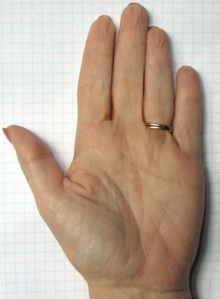 A new paper provided both new direct evidence and a meta-analysis of measurements of 2D:4D finger ratios in transsexuals, both FtM and MTF. Such measurements are interesting because it is known to be influenced by testosterone levels in utero and thus an indirect measure of testosterone exposure that might influence brain sexual dimorphism.
A new paper provided both new direct evidence and a meta-analysis of measurements of 2D:4D finger ratios in transsexuals, both FtM and MTF. Such measurements are interesting because it is known to be influenced by testosterone levels in utero and thus an indirect measure of testosterone exposure that might influence brain sexual dimorphism.
What is doubly exciting about this paper is that the authors fully comprehend the overwhelming evidence for the two type taxonomy and of the (mild) scientific controversy regarding sexual orientation vs. age of onset as the best clinical markers for the two taxons. The study is open access so I highly recommend following the link to it and reading it for yourself. The study is also interesting because of where it was conducted; Iran.
Iran is a Muslim country which while being extremely homophobic, both culturally and legally, treats transsexuals fairly well, at least legally and medically. Make no mistake, culturally, it is far from truly accepting. Further, Iran is considered a “Collectivist Society” according to the Hofstede Individualism vs. Collectivism Index. Lawrence has shown that this index highly correlates with the percentage of non-androphilic (and thus likely autogynephilic / late onset) transwomen transitioning in a given culture. Thus, we would expect that there were fewer such transwomen in the study and the reported data bear this out.
Let’s look at the new data they provide:
Table 1
Means (and SD) for 2D:4D in the left and right hand for transmen, transwomen, control women, and control men
|
Transmen |
Control women |
Transwomen |
Control men |
|
|---|---|---|---|---|
|
Left 2D:4D |
0.991 (0.034) |
0.991 (0.032) |
0.981 (0.033) |
0.974 (0.029) |
|
n = 104 |
n = 53 |
n = 88 |
n = 56 |
|
|
Right 2D:4D |
0.981 (0.030) |
0.983 (0.033) |
0.972 (0.029) |
0.959 (0.033) |
|
n = 104 |
n = 53 |
n = 89 |
n = 56 |
Table 2
Means (and SD) for 2D:4D in transsexuals’ left and right hand as a function of early or late onset of gender dysphoria
|
Transwomen |
Transmen |
|||
|---|---|---|---|---|
|
Early onset |
Late onset |
Early onset |
Late onset |
|
|
Left 2D:4D |
0.982 (0.034) |
0.975 (0.022) |
0.988 (0.033) |
1.009 (0.031) |
|
n = 80 |
n = 8 |
n = 92 |
n = 12 |
|
|
Right 2D:4D |
0.973 (0.029) |
0.963 (0.026) |
0.977 (0.028) |
1.007 (0.027) |
|
n = 81 |
n = 8 |
n = 92 |
n = 12 |
|
Before the analysis of transfolk, it would be a good idea to scale the effect by looking at the effect size between the controls. The difference between control women and men is d= 0.56 for the left hand and d= 0.76 for the right. This is only a moderate effect size.
Although the number of late onset is small, and thus must be viewed with caution, the analysis is still very interesting and would seem to confirm (agree) with the two type hypothesis. Consider that the two MTF types have a small but distinct difference of d= 0.24 for the left hand and d= 0.22 for the right. When we compare early onset type to the male controls we get d= 0.25 and d= 0.45 for the right. When we compare early onset to female controls we get d= -0.27 for the left and d= -0.32 on the right. This shows that early onset transwomen are roughly halfway between the controls, and if anything a bit closer to the female controls.
But even more intriguing, and the reason for trusting this interpretation is that when we compare the late onset population to the male controls we see that it exactly agrees with the hypothesis that the late onset type is essentially like the majority heterosexual male population and not at all feminized, with effect sizes that are, statistically speaking, non-existent at d= 0.04 and d= 0.12 for the left and right hands respectively.
This shows that early onset MTF type has notably hypomasculine (feminized) hands while the late onset MTF type does not, and thus in agreement with other data that supports the two type MTF taxonomy.
But what about the FtM transmen? Here we see an even more intriguing set of data.
The two FtM types have a moderate to substantial, very notable, difference of d= -0.66 for the left hand and d = -1.07 for the right, indicating that early onset transmen are far more masculine than late onset. When we compare the early onset FtM to female controls we find effect sizes of d= -0.09 for the left hand and d= -0.20 for the right indicating a non-existent to small masculinization signal.
However when we compare the late onset FtM to female controls we see a very different pattern with effect sizes of d= 0.57 for the left and d= 0.80 for the right. The positive sign indicates that late onset transmen have a more feminine 2D:4D ratio than control women (!!). And the effect size difference between early and late onset transmen is far greater than the difference between control men and women (!!!).
This, if replicated, is very big news. It would support the notion that transmen also exhibit two taxons as has long been suspected, one that is masculinized in both behavior, sexual orientation, and very mildly in appearance, the other that is very feminine, androphilic, and autoandrophilic, the mirror image of late onset transwomen.
Further Reading:
Essay on Cultural Difference in Percentage of HSTS vs. AGP Transwomen
Reference:
Sadr, M., Khorashad, B.S., Talaei, A. et al. “2D:4D Suggests a Role of Prenatal Testosterone in Gender Dysphoria” Archives of Sexual Behavior (2020)
https://doi.org/10.1007/s10508-020-01630-0
Comments Off on 2D:4D Evidence Supports Transsexual Taxonomy
Latest Trans Taxonomy Study
 Wondering if the latest science studies have proven Blanchard was wrong? Surely by now they are finding Bailey was barking up the wrong tree? That Lawrence has been debunked?
Wondering if the latest science studies have proven Blanchard was wrong? Surely by now they are finding Bailey was barking up the wrong tree? That Lawrence has been debunked?
A study published just days ago, this year, 2019 looked to test the validity of the two type taxonomy by examining forty (N=40) transwomen before and after SRS at a clinic in Germany. European researchers have for years preferred to classify the two types as “early” vs. “late” onset of gender dysphoria. Most have used the age of puberty as the separation line under the (false) assumption that autogynephilic sexuality does not occur in pre-adolescents. However in this study, they chose to use the age of legal majority, 18 years old, as the dividing line.
Given that many acknowledged autogynephiles state that their first experiences with erotic cross-dressing began in adolescence, this choice of age would seem to be misplaced. However, in using statistics, any dividing line used to cut a single population into two that shows a significant difference between two groups is useful.
Consider a dividing line that is totally random and unlikely to have any correlation with putative differences between two populations (e.g. odd or even date of birth). If that divisor is meaningless, even if there are two different populations, that random divisor will fail to sort them and the two populations will not appear to be different when measured. They will have the same percentages of each population. If however, even a poor divisor that has some, albeit, imperfect correlation, the two populations will be somewhat sorted and may show statistically strong differences when measured. That difference is enough to show that there are in fact two different populations in the larger pool. This is what Zavlin, et Al. have found.
I would not say that this study is perfect, given that we know that the age of onset of gender dysphoria is often misreported, and the authors fully acknowledge this. Further, the authors didn’t even attempt to collect data on autogynephilia… and chose not to analyse their data using sexual orientation as the independent variable which has been repeatedly found to provide a stronger statistical signal. Yet, in spite of these severe weaknesses and missed opportunities, their conclusion was still,
“Our study strengthens the theory that there are 2 distinct age-related subgroups within the MtF transgender population undergoing GAS.”
Specifically, the study, in agreement with earlier studies, found that “early onset” transwomen were more likely to be exclusively androphilic than “late onset” and to transition at a significantly younger age. Put another way, exclusively androphilic transwomen are far more likely to report having experienced an early onset of gender dysphoria than non-exclusively androphilic. Note there are twice as many non-androphilic subjects as androphilic.
N=40 Androphilic Non-Androphilic
Early 10 (77%) 9 (33%)
Late 3 (23%) 18 (67%)
There are also very distinctive bimodal distributions in the self-reported age of onset and of age of obtaining surgery, strongly indicative of the two type taxonomy. This finding is in agreement with an earlier study that also found a bimodal distribution of obtaining surgery.

What I found the most interesting, in agreement with my own experience and in talking to other transwomen, is that while the “late onset” group found psychotherapy to be nearly universally useful, “early onset” transwomen did not. Interestingly, if we compare the data carefully, it supports the notion that androphilic transwomen did not find psychotherapy useful. I’ve commented in other essays that psychotherapists mistakenly apply what is useful for autogynephiles to androphilic transwomen to negative effect (e.g. advising a highly gender atypical androphilic transkid to seek out opportunities to privately express her “feminine side” makes no sense, risibly so…). Here we seem to have data confirming my anecdotal observations.
The key take-away from this study is that the two type taxonomy is still very much being supported by the evidence and that those who hope that it will be proven wrong continue to be disappointed.
Further Reading:
Essay on Age of Onset vs. Sexual Orientation
Reference:
Zavlin, D. et Al., “Age-Related Differences for Male-to-Female Transgender Patients Undergoing Gender-Affirming Surgery”, Journal of Pediatric Surgery (2019)
https://doi.org/10.1016/j.esxm.2018.11.005
Comments Off on Latest Trans Taxonomy Study
Once Again, With Feeling…
 Or, How Do We REALLY Know That There Are Two Types of Transwomen?
Or, How Do We REALLY Know That There Are Two Types of Transwomen?
One would think that with years of both clinical and scientific evidence to support the Two Type Taxonomy of MTF transexuality, we would no longer have need of essays that explain how we know this to be true, but no… sillyolme, nothing is so obvious as to be truly self-evident. So, once again, it’s time to write a clear, concise, yet also complete explication of how we know that there are two and only two types of transwomen.
First, we need to know a bit about epidemiological research into etiology. In medical science we often recognize that a given medical entity exists because of its pattern of symptoms that collectively we call a syndrome. After recognizing a syndrome, science then attempts to determine an etiology, if it can. Here it is important to recognize that the existence of a given symptom in itself does not define a syndrome. Consider fever as a symptom. Today, after much research, we know that it is caused by our immune system attempting to fight off an infection. But that infection may be from any of literally millions of different entities, from eukaryotic parasites, bacteria, to viruses. One would not say that just because two individuals both have fevers, or that a given medicine helps reduce both individual’s fevers, that they have the same etiology. Yet, when it comes to transsexuals, this seems to be the assumption by both transexuals and the public at large. As I will show, this is just not the case.
We also need to know a bit about statistics, most critically, about the concept of “effect size” and what it means. Effect size is a measure of how different two populations are from one another when comparing their mean (average) and their variance (how much spread in a given measure exists within a given population). If two populations have the same average, they have by definition an effect size between them of exactly zero, no matter the variance within the populations. But even if they do not have the same average, if the variance in each is so large that it dwarfs the difference in average, it has a small and not very important effect size. But if two populations have a difference in their average and no overlap in their variance, than there is a large effect size. We calculate the effect size using a standard formula called “Cohen’s d”.
Why is this important? Because to determine if there are in fact two (and only two) types, we must show that the Null Hypothesis, the assumption that there is only one type, is wrong by demonstrating that we consistently find that there is a large enough effect size in a number of measures that consistently cluster together. In science we never “prove” an hypothesis… we only disprove one. If the null hypothesis holds, there should be no such effect sizes. So, in this essay, I’m going to review some of the evidence, demonstrating that there are respectable effect sizes and that they consistently cluster together. Here’s the key, we DON’T have to show that that there are characteristics that give 100% vs. 0%… only that there ARE differences, respectfully large effect sizes, in order to disprove the null hypothesis. In fact, if a study did show 100% vs. 0%, we would expect that the data was bogus, made up, given well known real world difficulties in getting perfectly truthful and accurate answers from people.
Further Reading on Effect Size
Having prefaced our discussion, let’s describe our hypothetical two types, as described by experienced clinicians:
One group is exclusively attracted to men, transitions quite young, passed as girls/women with relative ease, were noted to be feminine (sissy boys) by parents and teachers as children, preferred female playmates, avoided rough’n’tumble play, and were unlikely to report finding wearing women’s clothing to be sexually arousing.
The other grouping was sexually attracted to women (as evidenced by extensive sexual experience with women, marriage, and siring children) but may identify as bisexual or asexual, transitioned later in life, rarely passed successfully as women, were considered to have been typical boys (“boyish”) by their parents and teachers, and were very likely to report finding wearing women’s clothes to be, or once had been, sexually arousing.
But what is the evidence and how large are the effect sizes?
Let’s look at some data. In a study by Lawrence, conducted in 2005 among those who had had SRS by Toby Meltzer, she has three groups, those who had always been exclusively into men (androphilic), those who had always been exclusively into women (gynephilic), and those who claimed that their sexuality has switched from women to men (bisexual).
| Attraction before SRS/Attraction after SRS: | F/M | F/F | M/M |
|---|---|---|---|
| Participant characteristic | (n = 30) | (n = 50) | (n = 17) |
| Mean age at SRS (SD) | 45 (8.4) | 44 (9.1) | 34 (9.2) |
| Mean age at living full-time in female role (SD) | 42 (11.3) | 42 (9.6) | 28 (8.8) |
| Very or somewhat feminine as a child, in own opinion | 41% | 45% | 76% |
| Very or somewhat feminine as a child, in others’ probable opinion | 21% | 24% | 76% |
| Autogynephilic arousal hundred of times or more before SRS | 52% | 58% | 18% |
.
So, let’s look at the effect size of ages at SRS and of social transition. When we compare those who had been consistently gynephilic to those who would best be described as bisexual (having claimed sexual attraction to both men and women) we see that Cohen’s d for age of SRS is only 0.11, so tiny as to be essentially zero. For age of social transition Cohen’s d is 0.0000 = zero. Thus, we would have to say, for this characteristic and these two populations the null hypothesis is not disproven. Again, this does not mean that the null hypothesis is proven… only that it is not disproven. Gynephilic and bisexual transwomen could be the same underlying etiology… or not.
Oh… but let’s look at the androphilic group compared to these other two groups, shall we? Comparing age of SRS between the bisexual and androphilic Cohen’s d = 1.25, a very large effect size. Comparing their ages of social transition Cohen’s d = 1.48, also a very large difference. Finally, looking at the ages of SRS and ages of social transition between the gynephilic and androphilic groups Cohen’s d = 1.09 and 1.44 respectively. This very powerfully disproves the null hypothesis. Sexual orientation is definitely important and supports the two type hypothesis.
Lest you think this result is from only one study, consider the even larger Nuttbrock study in which we see that of those who have started HRT, fully one half of the exclusively androphilic had done so before they turned age 20, while only one exclusively gynephilic individual had done so.
Our description of the two types also mentioned other characteristics, such as gender atypicality and autogynephilia. Now here, we have a small problem in that we don’t have measures that have a continuous value nor a variance. These were bivalued. However, interestingly, because people don’t always answer perfectly, we can use the number of people who answer a given way as a pseudo continuous measure of the real continuous value. That is to say, if only a small number say yes to a question, it’s likely that the real value is very small. If a large number answer yes to a question, it’s likely that the real value is very large. So, let’s look at the values for self image and likely impression to others of being gender atypical. Oh look, consistent with our earlier conclusion that the gynephilic and bisexual groups were in fact not really different groups, their answers are very similar at 41% vs. 45% and 21% vs. 24%. These are so close, that we might as well agree that they are identical. And once again, we see that the androphilic group scores are quite different at 76%. Notice something very interesting, the androphilic group scores for the two questions are identical, but the gynephilic and the bisexual both have the same difference, strongly supporting the null hypothesis that gynephilic and bisexual are not different. So, consistent with our earlier conclusion, the null hypothesis that there is only one group is very much disproven while the hypothesis that there are two and only two is strongly supported.
Before we leave Lawrence’s study, lets look at the issue of autogynephilia. Again, we have a bivalued question whether one had experienced hundreds (or more) episodes of autogynephilic arousal to wearing women’s clothing. As before, we see that the gynephilic and bisexual groups are very similar at 52% vs. 58%, while the androphilic group had only 18%. So, once again, consistent with our earlier conclusion, the null hypothesis that there is only one group is very very much disproven and the hypothesis that there are two and only two is supported.
Associations between autogynephilia and sexual orientation
in MtF transsexuals and transgender persons
%AGP: Gynephilic (includes bisexual and asexual) vs. Androphilic
| Study | Gynephilic AGP | Gynephilic NonAGP | Androphilic AGP |
Androphilic NonAGP |
||||||
| Blanchard (1985) | 46 | 17 | 15 | 85 | 75% vs. 15% | |||||
| Blanchard et al. (1987) | 60 | 13 | 5 | 47 | 82% vs. 10% | |||||
| Lawrence (2005) | 178 | 21 | 6 | 9 | 89% vs. 40% | |||||
| Smith et al. (2005) | 28 | 16 | 18 | 40 | 64% vs. 31% | |||||
| Nuttbrock et al. (2011) | 131 | 48 | 90 | 301 | 82% vs. 23% | |||||
| TOTALS | 443 | 115 | 134 | 482 | 79% vs. 22% |
Note: The four center columns display numbers of participants
Again, lest you think this result is restricted to only this study, we have seen this replicated by Buhrich (1977), Freund (1982), Blanchard (1985), Doorn (1994), Smith (2005), and Nuttbrock (2011), Laube (2020), in separate studies spanning five decades, collectively involving over a thousand transsexuals to date. In fact, this is one of the most repeated and reconfirmed scientific finding regarding transsexuality.
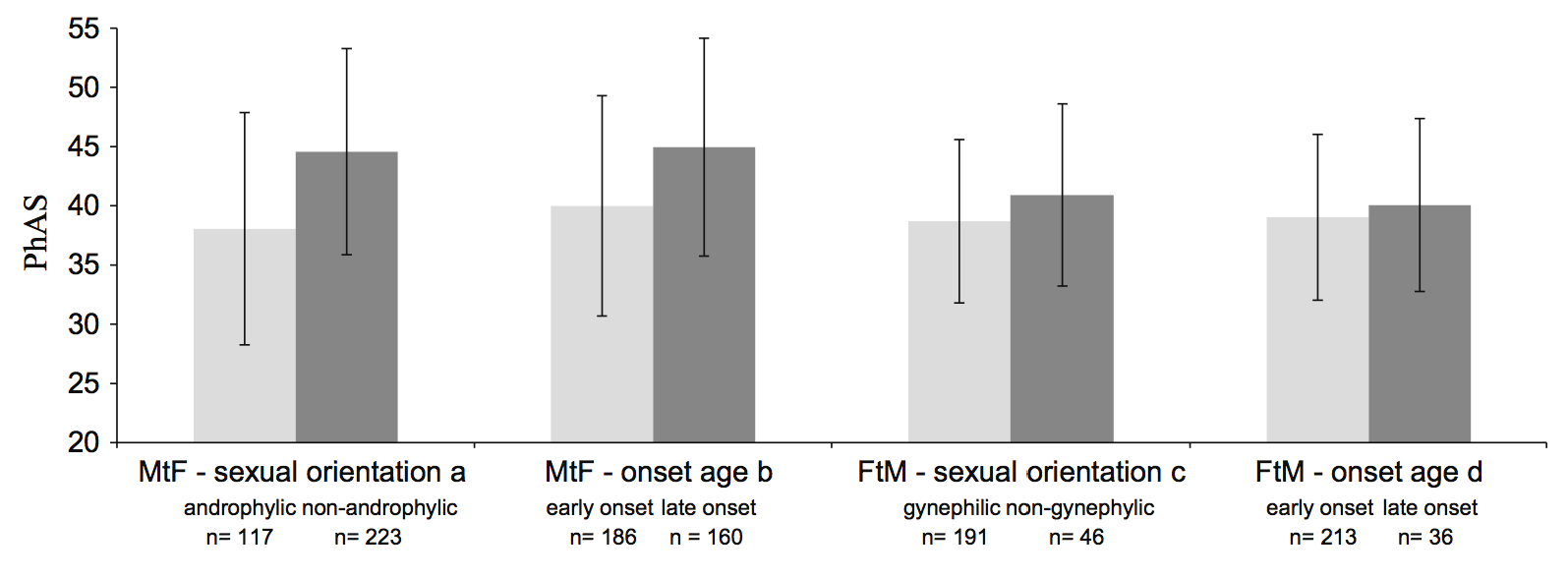
Another characteristic difference mentioned about the two types was passability. Fortunately, we have a clinical study from the Netherlands which showed a robust effect size d = 0.7 difference between androphilic and non-androphilic transwomen. The graph above shows the data. The higher the score, the more ‘readable’ (less passable) the individual. From the graph, we see that the most passable non-androphilic (gynephilic and bisexual) is just average for the androphilic population.
When we add in the growing evidence that there is a distinct difference between the brains of androphilic vs. gynephilic & bisexual, the null hypothesis that there is only one type is not just merely dead, but most sincerely dead.
Addendum 1/15/2018:
Study after study has shown that around 80% to 85% of “non-homosexual” transwomen readily acknowledge experiencing sexual arousal to cross-dressing, at least in adolescence, while they also show that around 50% acknowledge continuing arousal. This leaves 15% or so who say that they never experienced sexual arousal to cross-dressing. As we’ve seen, social desirability bias is strongly operating. At least some percentage of the population is not being honest. Interestingly, there is a new study exploring the subject of honesty and dishonesty. It was discovered that there are three types of people that I shall paraphrase as “always honest”, “mostly honest”, and the “never honest”.
Guess what the percentages were?
“always honest” = 50%
“mostly honest” = 35%
“never honest” = 15%.
Wow, what an interesting coincidence.
Many transwomen who are critical of the two type taxonomy have specifically called out Blanchard and any who accept and advocate the taxonomy as being ugly transphobes for having called transwomen liars. But are we to suppose that transwomen as a population are somehow more saintly and honest than the general population? Phhfft !
https://www.technologyreview.com/s/609924/a-field-guide-to-deception/
Further Reading:
Comments Off on Once Again, With Feeling…
Brainstorm
 A new review paper has just been published on the current status of brain structure research in transsexuality. Interestingly, it was submitted to the Archives of Sexual Behavior two full years ago. This suggests that it went through a rather thorough peer review. For myself, the first thing I do when reading a review paper is to see that the reference list is comprehensive to ensure that the authors aren’t cherry-picking. In this case, they are not. The paper looks to be very complete and scientifically honest. You may wish to read it yourself, as it is not behind a paywall, thankfully.
A new review paper has just been published on the current status of brain structure research in transsexuality. Interestingly, it was submitted to the Archives of Sexual Behavior two full years ago. This suggests that it went through a rather thorough peer review. For myself, the first thing I do when reading a review paper is to see that the reference list is comprehensive to ensure that the authors aren’t cherry-picking. In this case, they are not. The paper looks to be very complete and scientifically honest. You may wish to read it yourself, as it is not behind a paywall, thankfully.
The paper is written rather densely, with a great deal of information and discussion; so much in fact, that I will likely be writing several essays covering a number of topics from it. At the high level, my regular readers will not be surprised at the primary conclusions drawn from the review, as I had already written about a fair number of the brain research papers. The authors offer this chief conclusion at the end of the paper,
“The review of the available data seems to support two existing hypotheses: (1) a brain-restricted intersexuality in homosexual MtFs and FtMs and (2) Blanchard’s insight on the existence of two brain phenotypes that differentiate “homosexual” and “nonhomosexual” MtFs”
The review of all of the available brain structure research fully supports the Two Type Taxonomy. In light of this, the authors recommend that future researchers take care to distinguish between the two types, lamenting that some studies in the review had not made this distinction, and further, that it is important that the control groups also be concordant with sexual orientation,
“The study of mixed samples implicitly assumes that transsexuals are a homogeneous group. This is far from the truth with respect to the onset of GD and sexual orientation. … These observations signify that control groups in studies of the transsexual brain must be homogeneous in regards to sexual orientation.”
The authors did find separate studies of androphilic “homosexual” MTFs and non-gender dysphoric gay men that used the same methods, such that a tentative comparison could be made,
“The only study on the CTh [cortical thickness] of homosexual persons that do not present gender dysphoria is by the Savic group (Abé et al.). If we compare this study with that of Zubiaurre-Elorza et al. on the CTh of homosexual MtFs, we see both studies report sex differences showing an F > M pattern in similar structures of the right hemisphere. But there is only one region, the pars triangularis, in which homosexuals and homosexual MtFs both present differences. However, these changes are in opposite directions. The pars triangularis of homosexual MtFs is thicker than in heterosexual male controls, while for homosexuals it is thinner than in heterosexual males. Thus, it seems that for transsexuals this region is feminized but demasculinized [i.e.: “different that straight men, but not in the heterosexual female direction” – K. Brown] in homosexual individuals. Interestingly, in both studies, the affected pars triangularis is in the right hemisphere. Nevertheless, confirming Blanchard’s prediction still needs a specifically designed comparison of homosexual MtF, homosexual male, and heterosexual male and female people.”
This is interesting, that there is a difference between gay men and androphilic transwomen? But the right hemisphere pars triangularis of all things? For left hemisphere dominant people, this region of the brain is believed to be involved in the understanding and production of prosody, emotionally nuanced speech modulation. We know this because individuals who have serious lesions in this area have trouble with prosody.
For more information, read the Wikipedia page on prosody.
Before anyone gets too excited about the possible implications for a neurological marker for androphilic transsexuality that differentiates them from gay men, we need to note that the brain exhibits neuroplasticity. That is to say, that like a muscle, exercise of particular skills causes the brain to increase in volume and neuron number in those regions used to supply that skill. If this is about language and more particularly, about language production that imparts an emotional / sexual identity / gender identity through one’s voice, the difference in this part of the brain may be caused by experience and practice.
For more information, read my essays on feminine speech production and on voice recognition.
On the other hand, it just might represent a real difference. We need more studies.
References:
Guillamon, A et al., “A Review of the Status of Brain Structure Research in Transsexualism” Arch Sex Behav (2016). doi:10.1007/s10508-016-0768-5
Comments Off on Brainstorm


Comments Off on The REAL Takeaway From The CDC Study On HIV/AIDS In Transwomen